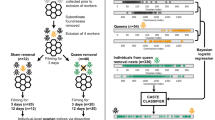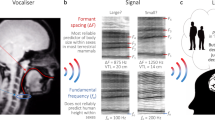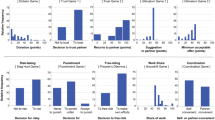Abstract
Organisms use signals of quality to communicate information about aspects of their relative phenotypic and genetic constitution1,2,3,4. Badges of status5,6,7 are a subset of signals of quality that reveal information about an individual's size and dominance. In general, signals of quality require high and differential costs to remain honest1,2 (that is, prevent low-quality cheaters from exploiting any fitness benefits associated with communicating high quality). The theoretically required costs for badges of status remain controversial because the development (or ‘production’) of such signals often seems to be relatively cost-free5,6,8. One important hypothesis is that such signals impose social (or ‘maintenance’) costs incurred through repeated agonistic interactions with other individuals9,10,11,12. However, convincing empirical evidence for social costs remains elusive6,7. Here we report social costs in a previously undescribed badge of status: the highly variable black facial patterns of female paper wasps, Polistes dominulus. Facial patterns strongly predict body size and social dominance. Moreover, in staged contests between pairs of unfamiliar wasps, subordinate wasps with experimentally altered facial features (‘cheaters’) received considerably more aggression from the dominant than did sham controls, indicating that facial patterns are signals and that dishonest signalling imposes social costs.
This is a preview of subscription content, access via your institution
Access options
Subscribe to this journal
Receive 51 print issues and online access
$199.00 per year
only $3.90 per issue
Buy this article
- Purchase on Springer Link
- Instant access to full article PDF
Prices may be subject to local taxes which are calculated during checkout





Similar content being viewed by others
References
Zahavi, A. Mate selection—a selection for handicap. J. Theor. Biol. 53, 205–214 (1975)
Grafen, A. Biological signals as handicaps. J. Theor. Biol. 144, 517–546 (1990)
Andersson, M. Sexual Selection (Princeton Univ. Press, Princeton, New Jersey, 1994)
Dale, J., Lank, D. B. & Reeve, H. K. Signaling individual identity versus quality: a model and case studies with ruffs, queleas and house finches. Am. Nat. 158, 75–86 (2001)
Rohwer, S. The social significance of avian winter plumage variability. Evolution 29, 593–610 (1975)
Senar, J. C. Plumage colouration as a signal of social status. Proc. Int. Ornithol. Congr. 22, 1669–1686 (1999)
Whiting, M. J., Nagy, K. A. & Bateman, P. W. in Lizard Social Behavior (eds Fox, S. F., McCoy, J. K. & Bairds, T. A.) 47–82 (John Hopkins Univ. Press, Baltimore, Maryland, 2003)
McGraw, K. J., Dale, J. & Mackillop, E. A. Social environment during molt and the expression of melanin-based plumage pigmentation in male house sparrows (Passer domesticus). Behav. Ecol. Sociobiol. 53, 116–122 (2002)
Rohwer, S. & Rohwer, F. C. Status signalling in Harris sparrows: experimental deceptions achieved. Anim. Behav. 26, 1012–1022 (1978)
Maynard Smith, J. & Harper, D. G. C. The evolution of aggression: can selection generate variability? Phil. Trans. R. Soc. Lond. B 319, 557–570 (1988)
Owens, I. P. F. & Hartley, I. R. Trojan sparrows—evolutionary consequences of dishonest invasion for the badges of status model. Am. Nat. 138, 1187–1205 (1991)
Johnstone, R. A. & Norris, K. Badges of status and the cost of aggression. Behav. Ecol. Sociobiol. 32, 127–134 (1993)
Tibbetts, E. A. Visual signals of individual identity in the paper wasp Polistes fuscatus. Proc. R. Soc. Lond. B 269, 1423–1428 (2002)
Röseler, P. F. in The Social Biology of Wasps (eds Ross, K. G. & Matthews, R. W.) 309–335 (Cornell Univ. Press, Ithaca, New York, 1991)
Reeve, H. K. in The Social Biology of Wasps (eds Ross, K. G. & Matthews, R. W.) 99–148 (Cornell Univ. Press, Ithaca, New York, 1991)
Eickwort, K. R. Differential variation of males and females in Polistes exclamans. Evolution 23, 391–405 (1969)
Pereboom, J. J. M. & Biesmeijer, J. C. Thermal constraints for stingless bee foragers: the importance of body size and coloration. Oecologia 137, 42–50 (2003)
Clutton-Brock, T. H. & Parker, G. A. Punishment in animal societies. Nature 373, 209–216 (1995)
Gobin, B., Heinze, J., Straetz, M. & Roces, F. The energetic cost of reproductive conflicts in the ant Pachycondyla obscuricornis. J. Insect Physiol. 49, 747–752 (2003)
Cole, B. J. The social behavior of Leptothorax allardycei Hymenoptera Formicidae time budgets and the evolution of worker reproduction. Behav. Ecol. Sociobiol. 18, 165–174 (1986)
Sledge, M. F., Boscara, F. & Turillazzi, S. Cuticular hydrocarbons and reproductive status in the social wasp Polistes dominulus. Behav. Ecol. Sociobiol. 49, 401–409 (2001)
Horridge, G. A. & Zhang, S. W. Pattern vision in honeybees (Apis mellifera): flower-like patterns with no predominant orientation. J. Insect Physiol. 41, 681–688 (1995)
Strassmann, J. E. in Natural History and Evolution of Paper-wasps (eds Turillazzi, S. & West-Eberhard, M. J.) 190–201 (Oxford Univ. Press, Oxford, 1996)
Whitfield, D. P. Plumage variability, status signaling and individual recognition in avian flocks. Trends Ecol. Evol. 2, 13–18 (1987)
Pärt, T. & Qvarnstrom, A. Badge size in collared flycatchers predicts outcome of male competition over territories. Anim. Behav. 54, 893–899 (1997)
Pryke, S. R. & Andersson, S. Carotenoid-based status signalling in red-shouldered widowbirds (Euplectes axillaris): epaulet size and redness affect captive and territorial competition. Behav. Ecol. Sociobiol. 53, 393–401 (2003)
Holberton, R. L., Able, K. P. & Wingfield, J. C. Status signalling in dark-eyed juncos, Junco hyemalis: plumage manipulations and hormonal correlates of dominance. Anim. Behav. 37, 681–689 (1987)
Shields, W. M. The social significance of avian winter plumage variability: a comment. Evolution 31, 905–907 (1977)
Watt, D. J. A comparative study of status signalling in sparrows (genus Zonotrichia). Anim. Behav. 34, 1–15 (1986)
Balph, M. H., Balph, D. F. & Romesburg, H. C. Social status signalling in winter flocking birds: an examination of a current hypothesis. Auk 96, 78–93 (1979)
Acknowledgements
Thanks to M. Andrade, P. Buston, B. Daley, C. Gilbert, A. Houde, D. Lank, K. McGraw, H. K. Reeve, T. Seeley, P. Sherman, W. Gronenberg and the FAB evolution group (S.F.U.) for helpful comments on the manuscript, D. Lank for assistance with the statistical analysis, W. Gronenberg and H. K. Reeve for research support and L. Marakon for research assistance. E.A.T. was supported by a NSF graduate fellowship and NIH Training Grant. J.D. was supported by a N.S.E.R.C. post-doctoral fellowship.
Author information
Authors and Affiliations
Corresponding author
Ethics declarations
Competing interests
The authors declare that they have no competing financial interests.
Rights and permissions
About this article
Cite this article
Tibbetts, E., Dale, J. A socially enforced signal of quality in a paper wasp. Nature 432, 218–222 (2004). https://doi.org/10.1038/nature02949
Received:
Accepted:
Issue Date:
DOI: https://doi.org/10.1038/nature02949
This article is cited by
-
Facial color diversity of Polistes paper wasps
Insectes Sociaux (2023)
-
Ornaments are equally informative in male and female birds
Nature Communications (2022)
-
Longitudinal effects of habitat quality, body condition, and parasites on colour patches of a multiornamented lizard
Behavioral Ecology and Sociobiology (2022)
-
Sisters doing it for themselves: extensive reproductive plasticity in workers of a primitively eusocial bee
Behavioral Ecology and Sociobiology (2022)
-
Do male panther chameleons use different aspects of color change to settle disputes?
The Science of Nature (2022)
Comments
By submitting a comment you agree to abide by our Terms and Community Guidelines. If you find something abusive or that does not comply with our terms or guidelines please flag it as inappropriate.



